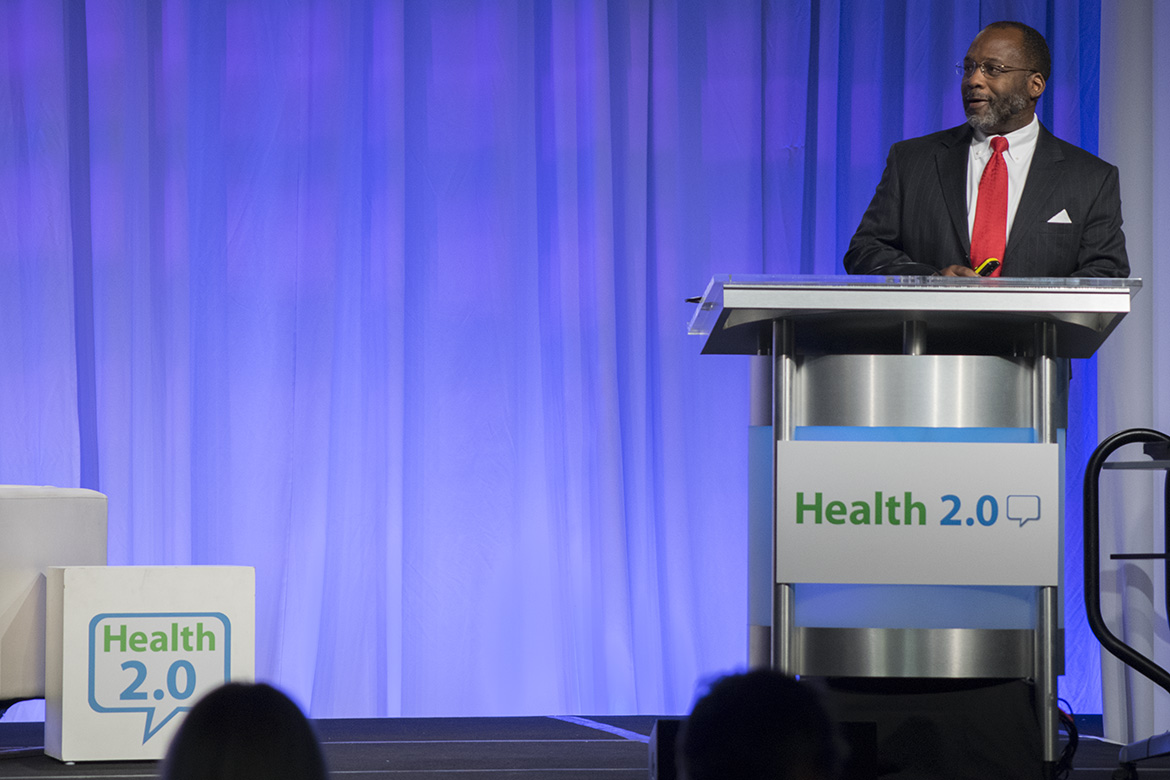With many gains in health information technology over the past decade, newly appointed National Coordinator for Health IT Vindell Washington, MD, took time at Health 2.0 last week to describe his first experience with health technology, what it means for the health care community and new tools for physicians and entrepreneurs.
Dr. Washington found his passion for health care technology as a captain in the U.S. Army. He was stationed in Haiti leading the emergency department in the 28th combat support hospital when a patient presented with “a fever, a rash, a really unusual constellation of symptoms,” he said.
Unable to diagnose the patient, Dr. Washington and his colleagues took the advice of a Colonel who suggested using the new equipment that may be helpful.
“We literally drove the Humvee to the side of the emergency department and set up our first satellite telemedicine hookup,” Dr. Washington said. “In about 20 minutes we had consult from the Walter Reed Army Medical Center helping us with the case … a dermatologist and an infectious disease doctor [helped us] make our first diagnosis of porphyria [a rare skin or nervous system disorder].”
“We were able to help that soldier and get him evacuated out of theater,” he said. “At the time I thought to myself, the way I practice medicine moving forward won’t ever be the same. Once you have had access to technology that allows you to significantly improve patient outcomes … you never want to go back. And why should you?”
Many physicians and health systems are developing innovative ways to bring telemedicine into practice. For example, the University of Virginia (UVA) Health System’s research efforts brought telemedicine to their ambulances to improve care for patients who are experiencing a stroke through its telestroke model.
UVA services a large, rural area, which means more time is needed to get patients to the hospital. During a stroke, every minute matters and their telestroke model is shortening that critical period of time.
Physicians who treat patients via telemedicine in multiple states, must have a medical license from each state. That process will be easier now that the Interstate Medical Licensure Compact is in effect. The compact will facilitate a speedier process with fewer administrative burdens for physicians seeking licensure in multiple states.
One health insurer earlier this year explained why it is embracing telemedicine, but only on one condition—that it provides value in practice for physicians.
Delegates at the AMA Annual Meeting in June adopted new policy that outlines ethical ground rules for physicians using these technologies to treat patients. The AMA in 2014 released model state legislation (log in) that provides guidance on licensure, payment and practice issues, and states are using this model to move telemedicine forward.
Physicians taking interoperability into their own hands
“Over the past decade, we made historic gains when it comes to the adoption and use of electronic health records (EHR),” Dr. Washington said. “It’s not just hospitals and doctors who are benefitting from this progress, it’s individuals and communities all across America.”
The vision that was established years ago for health care was a paperless, interoperable system in which physicians could share information to improve patient care. But physicians are working toward that so far unfulfilled promise of interoperability. In Kansas, the state medical society and KaMMCO Health Solutions realized that physicians were not involved in the development of the solutions being offered and created their own system that now connects 94 hospitals across the state.
And at Vanderbilt University, one team of physicians has figured out several innovative ways to use EHR data in practice at the point of care.
But challenges remain
“We saw survey data released by the team here at Health 2.0 suggesting that it can be difficult particularly for small tech innovators to access health data from some of the larger EHR vendors,” Dr. Washington said.
Data from a recent AMA digital health survey corroborates these concerns from the physician side. While physicians overwhelmingly see potential for digital health to favorably impact patient care—85 percent of those surveyed said that digital health solutions are advantageous—data privacy and workflow integration with EHR systems is still a major concern.
“That’s why we’ve launched challenges and funding announcements intended to unlock electronic data for innovators … so that [patients] can aggregate their data in one place, so that physicians will have a more user-friendly experience, and so that new products and standards can improve the flow of information for care teams.”
Dr. Washington discussed two additional tools developed by the ONC to help physicians maximize their EHRs:
- The new EHR contract guide, “EHR Contracts Untangled: Selecting Wisely, Negotiating Terms, and Understanding the Fine Print,” explains important concepts in EHR contracts and includes example contract language to help physicians and health administrators in planning to acquire an EHR system and negotiating contract terms with vendors.
- The Health IT Playbook is a web-based tool intended to make it easy for physicians and their practice administrators to find practical information and guidance on specific topics as they research, buy, use or switch EHRs. The Playbook features a collection of specific tools, resources and guides that can help physicians implement and use health information technology that best serves their practices—including supporting transitions toward alternative payment models.




